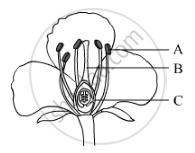Advertisements
Advertisements
प्रश्न
Prepare a slogan for campaign against female foeticide.
उत्तर
Avoid female foeticide, save girl child
APPEARS IN
संबंधित प्रश्न
Name the parts A, B and C shown in the following diagram and state one function of each.

State the function of flowers in the flowering plants.
A flower may have either male or female reproductive parts. Such a flower is called ______.
The fusion of male and female gametes is termed as ______.
Where are a plant's sex organs located?
What are the reproductive organs in a flower?
Draw a neat sketch of the stamen of a flower. Mark in it filament and anther.
What is made in anther of a flower?
What type of plants reproduce by sexual reproduction method?
What is seed? What are the parts of a seed? Explain with the help of a labelled diagram.
Name the part of a seed which grows into root.
In tobacco plant, the male gametes have 24 chromosomes.
What is the number of chromosomes in the female gamete?
Which of the following statements are true for flowers?
(i) Flowers are always bisexual.
(ii) They contain sexual reproductive organs.
(iii) They are produced in all groups of plants.
(iv) after fertilization they give rise to fruits.
Which of the following statements are true for sexual reproduction in flowering plants?
(i) it requires two types of gametes
(ii) fertilisation is a compulsory event
(iii) it always results in the formation of zygote
(iv) offsprings formed are clones
(a) (i) and (iv)
(b) (i), (ii) and (iv)
(c) (i), (ii) and (iii)
(d) (ii), (iii) and (iv)
When an insect sits on the flower of a plant then some particles A present in the top of little stalks in the flower attach to its body hair. When this insect now sits on the flower of another similar plant, then particles A attached to the hair of insect are put on the top of a flask-shaped organ at the centre of flower. The particle A grows a long tube b from the top of flask-shaped organ through which C moves down and reaches the bottom part of flask-shaped organ. Here C fuses with the nucleus of d contained in structure E. the fusion of C and D forms a new cell f which grows and develops into a seed of the plant.
(a) What are particles A? What is the process of transferring A from one flower to another flower of similar plant by the insect known as?
(b) What is the name of tube B?
(c) What is C which moves down through the tube B?
(d) Name D and E.
(e) What is F?
Fill in the blank by selecting suitable word:
A flower bearing only male or female parts is known as __________ flower.
Fill in the blank:
Seeds are formed from________.
Mention the function of Anther.
Mention the function of Stigma.
Draw a diagram of the longitudinal section of a flower exhibiting germination of pollen on stigma and label (i) ovary, (ii) male germ-cell, (iii) female germ-cell and (iv) ovule on it.
What is phototropism?
Answer the following question.
List two agents of pollination?
Accessory whorls : Calyx and corolla : : essential whorls : ______________
Define.
Inflorescence
The 3-celled egg apparatus at the micropylar end comprises of ______
What would be the number of chromosomes of the aleurone cells of a plant with 42 chromosomes in its roots tip cells?
Sperm and egg nuclei fuse due to ______.
The process of release of eggs from the ovary is called ______
In human beings, fertilization occurs in the ______
Pollen grains are produced by ______
Variations occur as a result of ______
Length of pollen tube depends on the distance between ______
Which among the following statements are true for sexual reproduction in flowering plants?
- It requires two types of gametes
- Fertilisation is a compulsory event
- It always results in formation of zygote
- Offspring formed are clones
Give any two examples of agents of pollination.
The figure below shows the concept of double fertilization. Complete the flow chart showing the progress at each step:

Sexual maturation of reproductive tissues and organs are necessary link for reproduction. Elucidate.
Type of sexual reproduction is ______.
Consider the following three flowers namely X, Y and Z. Which flower(s) would develop into a fruit?
| Flower X | Flower Y | Flower Z |
 |
 |
 |
